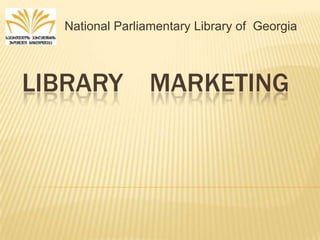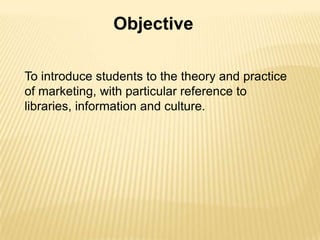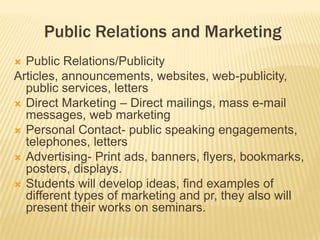Library marketing (eng)
- 1. National Parliamentary Library of Georgia LIBRARY MARKETING
- 2. A Few Words About Library Marketing Library Marketing is a job and function that should include training and support for all staff of the Library. Marketing the value of any library is a responsibility that should not be fulfilled by "employee job titles or job descriptions" - but should be a responsibility of all who have a stake in the survival of the Library facilities and the services & collections it offers its Community of users.
- 3. Libraries are more than just collections of books and other materials. ŌĆ£Libraries are dynamic forces in their communities with the power to improve livesŌĆØ (Jill Stover, www.librarymarketing.blogspot.com) Modern marketing demands that librarians look beyond their traditional roles ("outside the book") to find new ways to connect with people and further their success.
- 4. Objective To introduce students to the theory and practice of marketing, with particular reference to libraries, information and culture.
- 5. Learning Outcomes ŌĆóStudents will be able to demonstrate how to conduct a successful marketing campaign in a library. ŌĆó Students will be able to choose a marketing strategy which depends on specific factors facing the Library ŌĆó Students will be able to segment the market and target appropriate segments ŌĆó Students will understand the role of advertising, promotion and public relations. ŌĆó Students will be capable of developing a marketing plan.
- 6. Topics ŌĆó Introduction to Library Marketing Course ŌĆó Library Marketing Overview ŌĆó Marketing Libraries and Information ŌĆó Marketing Concepts ŌĆó Strategic Marketing For Libraries and Information ŌĆó The Marketing Environment ŌĆó Market Segmentation and Targeting ŌĆó Cultural Programming Overview ŌĆó Public Relations and Advertising ŌĆó Distribution and Pricing of Library and Information Services ŌĆó Marketing using listserv and Web sites ŌĆó Building relationships with stakeholders and donors.
- 7. Evaluation Criteria of Students Achievements ŌĆó Attendance 30% ŌĆó Participation in Discussions 20% ŌĆó Preparation and Presentations 20% ŌĆó Written Work 30%
- 8. Timetable The course covers 12 main topics, which continue during the semester. The duration of the course including theory and practice is 45 hours. Among them: ŌĆó Lectures 24 hours ŌĆó Practical work 21 hours
- 9. Assignments The module has the following three assignments: The 1st assignment: Students should write a brief report segmenting users of the National Parliamentary Library of Georgia. You should then select one segment and discuss its needs. Length: 1000 words. Weighting: 25% Due : 5th week.
- 10. The 2nd assignment: Write a brief report on the marketing of cultural activities (or one particular cultural activity) at the National Parliamentary Library of Georgia. Length: 1000 words. Weighting: 25%. Due : 10th week.
- 11. 3rd assignment Students will devise a marketing plan for a product or service at The National Parliamentary Library of Georgia. You should select a group of users and provide a rationale for linking the product or service with the particular group. Your plan should be linked to marketing theory and practice. You should include references to relevant literature, both general marketing literature and literature specific to library, information, and cultural marketing.
- 12. The duration of the presentation will be 20 minutes, which should be followed by a 2500 word write up Weighting: 50%. (25% for presentation and 25% for write up.) Due : 15th week.
- 13. Topics Weeks Monday Tuesday Wednes. Thursd. Friday Introduction to Library I X Marketing Course Library Marketing Overview I X Marketing Libraries and II X X Information discussion Marketing Concepts III X X discussion Strategic Marketing For IV X X Libraries and Information discussion 1st Assignment V Preparation X X Marketing Environment VI X X discussion Market Segmentation and VII X X Targeting discussion Cultural Programming VIII X X Overview discussion Public Relations& IX X X Advertising discussion
- 14. Topics Weeks Monday Tuesday Wednes. Thursd Friday . 2nd Assignment X X X discussion Distribution and Pricing of XI X X Library and Information discussion Services Marketing using listserv and XII X X Web Sites discussion Building relationships with XIII X X stakeholders and donors. discussion Practice XIV X X X X 3nd Assignment XV Preparation X X
- 15. Course Evaluation Made by Students At the end of the course students will be given the questionnaires to evaluate theory as well as practices in order to take their opinions into account in future. ŌĆó Involvement ŌĆó Understandability ŌĆó New information ŌĆó Challenge ŌĆó Materials selected properly
- 16. Recommended Readings ŌĆó ßāÜßāØßāæßā¤ßāÉßā£ßāśßā½ßāö, ßāĢ. (2005) ßāøßāÉßāĀßāÖßāößāóßāśßā£ßāÆßāśßāĪ ßāĪßāÉßāżßāŻßā½ßāĢßāÜßāößāæßāś. ßāŚßāæßāśßāÜßāśßāĪßāś: ßāÜßāÉßāøßā×ßāÉßāĀßāś, 79 ßāÆßāĢ. ŌĆó ßāøßāÉßāĀßā©ßāÉßāĢßāÉ, ßāź. (1990) ßāøßāÉßāĀßāÖßāößāóßāśßā£ßāÆßāśßāĪ ßāĪßāÉßāżßāŻßā½ßāĢßāÜßāößāæßāś, ßāŚßāæßāśßāÜßāśßāĪßāś: ßāŚßāæßāśßāÜßāśßāĪßāś: ßāŚßāæ. ßāŻßā£ßāó-ßāśßāĪ ßāĪßāóßāÉßāøßāæßāÉ, 108 ßāÆßāĢ. ŌĆó ßāŚßāÉßā¦ßā£ßāśßāÉßā©ßāĢßāśßāÜßāś ßāÆ. (2007) ßāśßā£ßāØßāĢßāÉßā¬ßāśßāŻßāĀßāś ßā×ßāĀßāØßā¬ßāößāĪßāößāæßāśßāĪ ßāøßāÉßāĀßāŚßāĢßāÉ ßāæßāśßāæßāÜßāśßāØßāŚßāößāÖßāößāæßā©ßāś, ßāæßāśßāæßāÜßāśßāØßāŚßāößāÖßāÉßāŚßāøßā¬ßāØßāōßā£ßāößāØßāæßāśßāĪßāÉ ßāōßāÉ ßāĪßāÉßāæßāśßāæßāÜßāśßāØßāŚßāößāÖßāØ ßāĪßāóßāÉßā£ßāōßāÉßāĀßāóßāößāæßāśßāĪ ßāÆßāÉßā£ßā¦ßāØßāżßāśßāÜßāößāæßāÉ, ßāŚßāæßāśßāÜßāśßāĪßāś ŌĆó Kotler, P. (2000) Marketing management: the millennium edition, 10th ed., Prentice Hall. ŌĆó Marshall, N.J. (2001) Public relations in academic libraries: a descriptive analysis, Journal of Academic Librarianship, 27 (2), 116-21. ŌĆó Robertson, D.A. (2005) Cultural Programming for Libraries: American Library Association, Chicago. ŌĆó Drucker, P. F. (2001) Management Challenges for the 21st Century. ŌĆó Lovelock, C.H. (1975) A market segmentation approach to transit planning, modeling and management, Proceedings, Sixteenth Annual Meeting Transportation Research Forum, pp. 247-258
- 17. Cultural Programming for Libraries
- 18. Linking libraries, communities and culture ŌĆ£Culture is the name for what people are interested in, their thoughts, their models, the books they read and the speeches they hear, their table talk, gossip, controversies, historical senses and scientific painting, the values they appreciate, the quality of life they admire. All communities have a culture. It is the climate of their civilizationŌĆØ. (Walter Lippmann)
- 19. What is Cultural Programming ’āÆ Libraries role and mission in learning and Society ’āÆ top 10 reasons to do cultural programming ’āÆ Who is doing and why ’āÆ Planning ’āÆ Setting goals and objectives ’āÆ Evaluation, questionnaires, interviews, Data gathering ’āÆ Program series planning and budgeting worksheets Practical training- students will prepare examples based on the learned materials.
- 20. Developing Audiences and Collaboration ’āÆ What is the library audience ’āÆ Targeting audience and reaching new readers ’āÆ Collaboration, finding new partners ’āÆ Program examples for different audiences ’āÆ Working with community organizations and partners Students begin to develop their own program on the bases of the National Parliamentary Library
- 21. Series, Formats, Themes ’āÆ Program formats and series ’āÆ Presentations, literary evenings, lectures, workshops, thematic exhibitions ’āÆ Performances, differences locally based and travelling programs ’āÆ Theme, description and ideas for new programs, planning activities ’āÆ Working with authors ’āÆ Venues organization details
- 22. Funding, Marketing and Public Relations for Programming ’āÆ Organizational support ’āÆ Finding sources for the programs and activities ’āÆ Proposal writing ’āÆ Networking ’āÆ Defining target audience ’āÆ Choosing communication methods
- 23. Public Relations and Marketing ’āÆ Public Relations/Publicity Articles, announcements, websites, web-publicity, public services, letters ’āÆ Direct Marketing ŌĆō Direct mailings, mass e-mail messages, web marketing ’āÆ Personal Contact- public speaking engagements, telephones, letters ’āÆ Advertising- Print ads, banners, flyers, bookmarks, posters, displays. ’āÆ Students will develop ideas, find examples of different types of marketing and pr, they also will present their works on seminars.
- 24. Digital Programs ’āÆ Building of digital materials on culture ’āÆ Digital exhibitions ’āÆ Digital lectures ’āÆ Digital conferences Preparing all segments of digital programs Students will choose themes for digital programs and develop the program from beginning to end.
- 25. A LOT OF THANKS

























